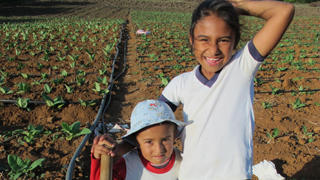Girls crossing the desert - a reflection of an agricultural researcher

On International Women's Day 2015, Jacob van Etten, agricultural researcher with Bioversity International who is based in Central America, reflects on the sudden surge of child migrants and especially young girls from Guatemala, Honduras and El Salvador, who risk their lives to reach the United States.
On International Women´s Day 2015, Jacob van Etten, agricultural researcher with Bioversity International based in Central America, reflects on the sudden surge of child migrants and especially young girls from Guatemala, Honduras and El Salvador, who risk their lives to reach the United States.
Last year, when we participated in an agricultural fair in Honduras to show some of our research results, the organizers were forced to shift the fair’s location only weeks before event. The agricultural research centre where the fair was to be celebrated was suddenly no longer available. It had been converted into a shelter to receive deported child migrants who were being returned from the US.
Just months before, the issue of child migration had grabbed headlines in the US. Many unaccompanied children had risked their lives to cross Mexico and arrive at the US border. Most came from Honduras, Guatemala and El Salvador, the so-called Northern Triangle of Central America. Many of them, more than usual, were girls.
The question that has been bothering me, an agricultural researcher, is if agriculture has anything to do with the root causes of child migration from Central America to the US. Some weeks earlier, a journalist from The Huffington Post had called me to ask if the surge in child migration was due to climate change, my area of work. The year 2014 was a bad year for agriculture. The particular weather patterns had caused a fungal disease in coffee, a crop that provides paid work to many people in rural Central America. Also, 2014 was an extremely dry year. The rural families we work with in Guatemala mentioned how they were doubly hit by the coffee crisis and the drought. They were eating only twice per day, anticipating shortages later that year. Later in 2014, the government provided food aid to 250,000 families to survive the food crisis. Reports on migration do link it to a more pernicious effect of climate change. As the US pushes for biofuels, global food prices increase and large companies occupy more land to grow sugar and palm oil. This leaves poor families with higher food bills and less land to grow their crops. But I could not give a clear answer to the journalist confirming that this was what caused the child migration crisis. Also, it was difficult to imagine how climatic effects can explain why so many girls were leaving home.
Later in 2014 and 2015, United Nations High Commissioner for Refugees (UNHCR) reports became available based on interviews with migrant children who had arrived in the US. The children mentioned a mix of reasons for leaving. Very few mentioned just poverty to explain why they left. The main difference with previous periods of migration seems to be the spread of misinformation and the increase in gang violence in neighbourhoods, as well as violence within families. Violence is linked to the increased use of the Central American route to ship cocaine to the US, due to stricter prevention measures in Mexico. Competition between gangs causes much of the violence. Young girls often suffer sexual violence from gang members, which explains the increase in their unaccompanied migration.
What specific things can we do to improve the lives of young girls in Central America from an agricultural perspective?
Perhaps agricultural researchers can do very little; the issues are about narcotics, security and international policy. But I believe there must be things that can help to address the root causes of the current crisis. We know that violence rates are higher in cities. Urbanization has contributed to the precarious social conditions around cities in Central America where gang violence is most prominent. Preventing families from going to the city by creating economic opportunities in rural areas where social cohesion is higher, could help to protect girls against violence. Maps of the places where migrant children are coming from show that children are also from rural areas, especially from the western highlands of Guatemala, where the majority of the population is indigenous. We know that domestic violence in rural areas is more prominent in indigenous households.
One of the key ingredients of violence prevention in the region is youth employment, which often focuses on digital skills rather than areas such as agriculture. Bioversity International is creating digital tools for a better use of agricultural biodiversity, which is one of the main sources of wealth in the region. The use of information and communication technology (ICT) makes agriculture a more attractive area for young entrepreneurs. Our work on ICT should also help to create these opportunities.
In Guatemala and Nicaragua, Bioversity International is also starting work on economic diversification of agricultural systems to provide alternatives to coffee cultivation and create new opportunities using traditional crops to make new products. We should analyze how these opportunities can be catered towards young girls and women at risk from violence.
As someone who has lived for some years in Central America and written about its problems, it is humbling to realize how little I know about the causes of violence or the lives of young girls in the region. As an agricultural researcher working mostly on technologies to solve “slow” problems such as climate change, the urgent nature of gender violence in the region makes me feel quite powerless. So when helping to organize the agriculture fair in Honduras, it felt quite appropriate that the least we could do was offer the agricultural research centre as a temporary shelter for young migrants.
Read next about Bioversity International’s work in Central America with USAID
Photo: Children of farmers we work with in Latin America. Credit: Bioversity International/M.Beltran
